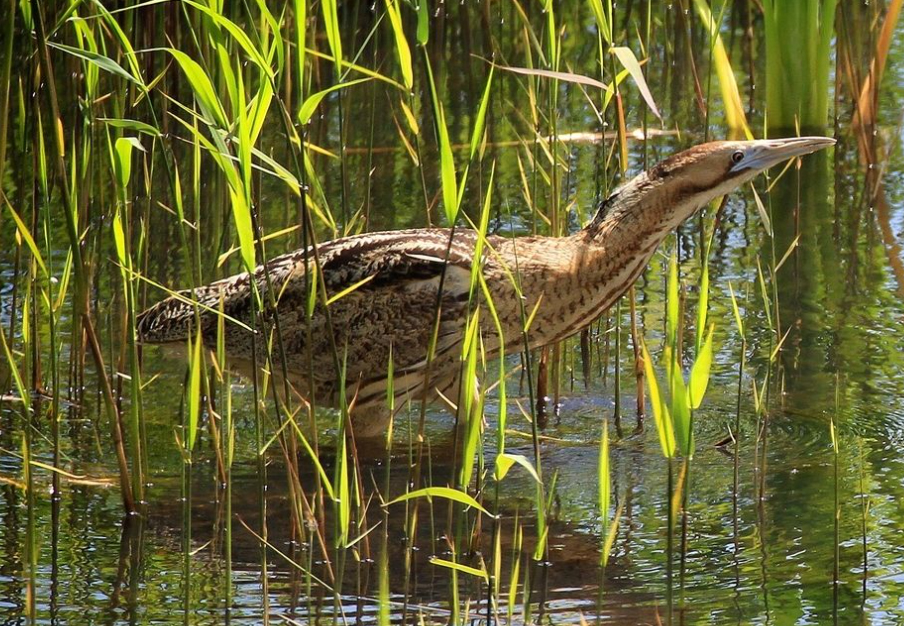Bird of the Year 2024: the elusive common bittern It is in full breeding season. According to the latest census, coordinated by SEO/BirdLife of 2021, published in the monograph Las Garzas in Spain, breeding population 2020-2021 and census method, the breeding population of common bittern In Spain there are 18 territories.
Information about the intangible common bittern It is very scarce. The Bird of the Year 2024, due to its elusive nature, makes it difficult to know the number of specimens and the territories it covers.
He common bittern was much more abundant in the first decade of the 20th century, but a significant decline has been recorded since the middle of that century, with a critical phase in the 1980s.
They are breeding population in Spainaccording to the last census coordinated by SEO/BirdLife of 2021, it is 18 occupied territories in the communities of Andalusia, Aragon, Castilla-La Mancha, La Rioja, Navarra and Catalonia. Already published in the Bird Atlas by SEO/BirdLife Before this date, the species’ range was shown to be very fragmented.
Important territories for the elusive Little Bittern
As mentioned in the monograph Las Garzas in Spain, breeding population 2020-2021 and census method the wetlands that occupy the region common bittern in 2021 these were the Hinojos Marisma (Doñana National Park) with 7 territories, the El Taray Lagoon (Toledo) with 3 territories, the Los Sotos Marisma (Doñana National Park) with 2 territories, Las Cañas (Navarra) with 1 territory, the Laguna de Sariñena (Huesca) with 1 territory, the Carrizal de Cofín (La Rioja) 1 territory, the Estanca de Escorón (Zaragoza) with 1 territory, Aiguamolls de l’Empordà (Girona) with 1 territory and the Laguna of El Cañizar (Teruel) with 1 territory.
During the During the winter the bittern is less demanding in habitat selection than during the breeding period, by being able to use non-natural wetlands such as rice fields, reservoirs, abandoned gravel pits and irrigation ponds. During this winter season, the bittern can even be found in a greater number of wetlands, including some on the Cantabrian coast, the Mediterranean coast and Galicia.
“Nowadays there are bird tracking platforms such as eBirdshow the latest observations of the common bittern on the Iberian Peninsula and help to better understand its distribution. Thanks to ornithologists and bird enthusiasts who daily record their observations in the field and share their work worldwide, we have a more global view of the bittern and birds in general,” said Blas Molina, Citizen Science Technician. SEO/BirdLife.
Characteristic “beautiful” of the bittern
He common bitterndeclared Bird of the year 2024 According to the popular vote, it reflects the poor situation in which the wetlands of the Iberian Peninsula find themselves. In concrete terms, the habitat of flooded reed fields is becoming increasingly scarce. Therefore, the Little Bittern has alarming populations and nests in few locations, although its potential distribution area is much larger.
He common bittern is being considered Critically endangered in the Red Bird Book of Spain, It is a good representative of the condition of the wetlands where it lives. Its small numbers and its mimetic brown plumage, which camouflages it perfectly in the reed fields where it nests, make it one of the most difficult birds to observe in the Iberian fauna. It is easier to locate it by its song, a characteristic ‘moo’ that reveals it on spring nights, during its breeding period.
Threats of the bittern in Spain
The main threat is degradation and inadequate management of their habitats, causing the direct destruction of wetlands. It presents a high level of threat and vulnerability due to loss of wetlands with large expanses of flooded reed beds, as a result of habitat change dehydration. How to collect Red Bird Book of SpaineIt is important to note that the conservation status of the common bittern and in particular the very small population size means that any type of mortality has a significant impact on the population at local, regional and national scales.
The reduction of surface water resources due to climate change and increasing recurrence of droughts have a negative effect on the degradation of swamp habitats in their range – especially relevant in the case of the common bittern– and therefore in the availability of suitable habitats. This contributed to the overexploitation of the water supply, reducing the flooded area of the wetlands.
Another major threat to the species is point and diffuse pollution. He common bittern It is a species sensitive to water eutrophication, a phenomenon that causes changes in the structure of vegetation and changes in fish populations in reed beds. Likewise, it is a species susceptible to pesticide contamination and spills due to its intermediate position in the food chain.
Great Bittern Bird of the Year Campaign
SEO/BirdLife carries out the campaign annually Bird of the Year to draw attention to some species of Spanish birds. With this action we highlight a species that requires special attention because of its poor conservation status or because it symbolizes the urgency of protecting the habitats in which it occurs. And thus to be able to demand measures from governments and institutions to preserve everyone’s natural heritage.

